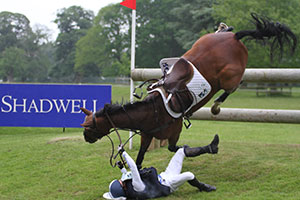
In the US, they formed a safety committee to look at the things like fence profiles in the wake of Philippa Humphries death earlier this year, and subsequently new, stricter rules for the placing of ground lines and fence dimensions are already in place. But they have been running the Maryland Hunt Cup for years over solid upright timber without decent ground lines, where the horses travel faster, without human fatality. So fence profiles are not the sole reason.
Anyway, you only have to look at the video of old championship courses to see that in the past lack of ground lines was extremely common. There were indeed plenty of falls but watch this video of the World Championships in 1986. Since then we have, in general, improved footing and made the courses more flowing with less sharp turns, both of which are good things, although the latter had the effect of slowing people down somewhat. Look at the fence construction rather than the riding because I am beginning to think that is half the problem. In those days, many of the fences were built of timber that was little sturdier than your average show jump pole.
More recently it was decided that heavier timber was preferable after a couple of near misses and nasty horse accidents with broken rails, but there is one great advantage of this sort of timber – it is the same advantage that jumping jockeys in England have at Cheltenham when they hit one of those obstacles at speed – both things will give slightly when hit by half a ton of horse travelling at 30 mph. Not much and not so much that a human would notice if you pushed on the fence with your hand. But enough to slow down the fall and reduce the stopping power of the impact.
Notice how many horses end up rolling over the fences as they fall. Still lots of falls, but not one true flip, end-over-end rotational. It is the physics of impact. The difference in hitting a brick wall in your car at 30 mph or a hedge at 50 mph. It is not the actual speed of the fall that kills, well not on its own anyway or many more jump jockeys would lose their lives (statistically jump racing is safer than eventing by the way), it is the force generated by the impact. Just a thought.
More thoughts are on the quiet disappearance of rules that were put on for good reasons and have quietly disappeared. I was struck in the last month or so by the horses who started cross country at Rio and turned up less than a month later at Burghley or those who started at Burghley did not complete and were presented again at Blenheim the next week. Short format has made that possible but there used to be a rule that said you could not start another cross country phase at a three day having started another within a month. I appreciate it is experienced riders doing this and the horses would have been well checked by vets, but is it a good precedent? Rather than go back to the drawing board and do some retraining, just double enter and turn up at the next one?
And what about the rule that insisted (in British eventing) that before heading to a three day event, the combination must have had a clear round at a similar level at national level (e.g. at an Advanced before a CCI3/4*) in the month or two before starting the three day event. Surely that was good rule? One decent prep run before a big test? There were horses that went to Rio, that were qualified by the bare minimum and but had not had a penalty free cross country in months.
And because we no longer have long format eventing, younger riders are not learning to jump plain fences at speed with good rhythm and balance. They are not helped because of the school of thought that believes that lower level eventing should contain skinnies, arrowheads and coffins, for example, assuming that they are all acceptable as long as they are small enough. This attitude has, however, in the UK at least, prevented many riders from learning balance over plain fences, where the horse can get himself out of trouble if the rider makes a mistake.
It is all very well making eventing all inclusive but it is a risk sport that you used to have to aspire to if you wished to compete. Giving horses points for clear rounds has not helped either over here because you can get one even if you go slowly and take lots of long routes. Eventing is hard, and if you want to do it, the qualification to upgrade a level needs to be equally hard. Why are people who have never even been placed at one level, upgrading to the next? Likewise with the horses.
Course design is no longer entirely covered by rules, some of it is governed only by “guidelines.” Maybe it is time that designers got more than guidance? Can eventing ever be the all inclusive sport the politically correct hope it will be? Personally, I do not think so, not until the day that all riders have the basic equestrian education to master three disciplines effectively. Perhaps therein lies the problem, event riders becoming the Jack of all trades and masters of none of them.
